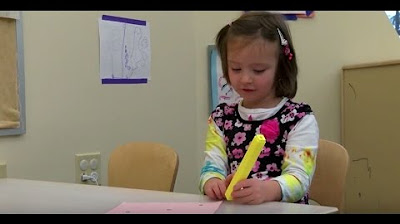The Progression of Early Number & Counting
Summary
TLDRThe video discusses the critical stages of early number understanding in young children, emphasizing concepts such as subitizing, more and less, rote counting, one-to-one correspondence, cardinality, hierarchical inclusion, and number conservation. It illustrates how children recognize and manipulate numbers before formal math education, highlighting the importance of these foundational skills in fostering mathematical comprehension. By understanding these concepts, educators can effectively support students' progress in numeracy, ultimately laying the groundwork for future mathematical success.
Takeaways
- 😀 Early number understanding involves recognizing number names and matching them to visual patterns, often without understanding quantity.
- 😀 Subitizing is the ability to recognize quantities at a glance, and it is crucial for early math development.
- 😀 Children often display perceptual subitizing, where they can identify numbers visually but may struggle to count them accurately.
- 😀 The concept of 'more' and 'less' is developed through visual comparisons before students learn to count.
- 😀 Rote counting is an essential skill for kindergarteners, but it often lacks a deep understanding of the count sequence.
- 😀 One-to-one correspondence is fundamental; students must tag numbers to objects accurately to grasp counting.
- 😀 Cardinality refers to the understanding that the last number counted represents the total quantity in a set.
- 😀 Hierarchical inclusion means recognizing that numbers are nested within each other, such as knowing 7 is part of 8.
- 😀 Number conservation is the concept that a quantity remains the same despite changes in arrangement, crucial for deeper numerical understanding.
- 😀 Engaging students with hands-on activities like matching objects helps solidify these early number concepts.
Q & A
What is subitizing, and why is it important in early math education?
-Subitizing is the ability to recognize the quantity of a small set of objects without counting them individually. It is important because it helps children develop a foundational understanding of numbers and quantity before formal math instruction.
What distinguishes perceptual subitizing from conceptual subitizing?
-Perceptual subitizing allows children to recognize quantities visually without understanding the underlying numbers, while conceptual subitizing involves understanding the relationships between numbers, such as recognizing that four can be made up of two and two.
How do students demonstrate their understanding of more and less?
-Students demonstrate their understanding of more and less by visually comparing quantities, such as determining which of two sets of objects has more without needing to count them.
What is rote counting, and how does it differ from understanding number sequences?
-Rote counting is the ability to recite number names in order without necessarily understanding their values or relationships. In contrast, understanding number sequences involves recognizing the position of each number within a counting system.
What is one-to-one correspondence in counting?
-One-to-one correspondence refers to the ability to match each object in a set to a number, ensuring that each item is counted exactly once. This concept is crucial for accurate counting.
How does cardinality relate to counting?
-Cardinality is the understanding that the last number counted in a set represents the total quantity of objects in that set. It signifies that counting has meaning beyond just reciting numbers.
What does hierarchical inclusion mean in early number sense?
-Hierarchical inclusion means understanding that numbers can be nested within other numbers; for example, if a child knows there are eight items, they also understand that there are seven items when one is removed.
How does number conservation play a role in a child's mathematical development?
-Number conservation is the understanding that quantity remains the same despite changes in arrangement or appearance. This concept is crucial for grasping that numbers can be decomposed and recomposed in various ways.
What teaching strategies can help develop early number sense in children?
-Teachers can use hands-on activities, such as counting objects, using manipulatives, and engaging in games that involve number recognition and comparison to develop early number sense.
Why is it important to provide sufficient time for students to develop early number concepts?
-Providing adequate time for students to explore and understand early number concepts is essential for building a strong foundation in mathematics, which supports their future learning and problem-solving abilities.
Outlines

This section is available to paid users only. Please upgrade to access this part.
Upgrade NowMindmap

This section is available to paid users only. Please upgrade to access this part.
Upgrade NowKeywords

This section is available to paid users only. Please upgrade to access this part.
Upgrade NowHighlights

This section is available to paid users only. Please upgrade to access this part.
Upgrade NowTranscripts

This section is available to paid users only. Please upgrade to access this part.
Upgrade NowBrowse More Related Video

One-to-One Correspondence: Supporting Mathematical Development in Young Children

Relasi dan Fungsi [Part 3] - Banyak Pemetaan & Korespondensi satu satu

Counting: Supporting Mathematical Development in Young Children

INTRODUCTION TO COUNTING TECHNIQUES (NUMBER OF A SET) || GRADE 10 MATHEMATICS Q3

Comparison: Supporting Mathematical Development in Young Children

Falsafah Jawa Bab Umur - Macapat - Selawe Seket Sewidak
5.0 / 5 (0 votes)